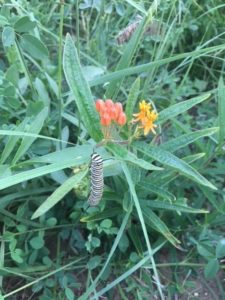Where Are The Monarchs Now?
The monarchs coming out of overwintering in Mexico have reached their breeding grounds in the southern U.S. and are nearing the end of life. Their offspring, the first generation of 2022 will soon continue the northward migration. Insect populations fluctuate with annual weather patterns and timing. Success for monarchs relies on well-timed and abundant resources, as well as minimal adverse weather or climate events (storms, winds, drought). This year’s late-spring conditions may mean that available habitat during the spring migration is sparse or immature when monarchs arrive. Generally, successful early generations set up the next generations for growth, so it is unclear how conditions this spring may impact the size of the fall migratory and overwintering generation. Follow their journey at Journey North.
Minnesota Farmer and Beekeeper Maximizes Acreage for Pollinators
Sundberg keeps 5,000 hives on his 60 acres, and originally farmed corn and soybeans on his 18 tillable acres. Before learning of and adopting the Bee and Butterfly Habitat Fund’s Seed a Legacy Program, he had switched to alfalfa to provide blooming forage for his bees.

“So what I did was take my 18 acres and…half of the planting is designed for honey bees and the other half is for monarch butterflies and other native insect plantings,” said Sundberg.
Sundberg farmed soybeans the year before he was planning on installing pollinator habitat. In the fall of that year, he cut it and left the stubble in preparation for a spring planting of the habitat. During the late spring of 2018, he applied herbicide across his land to eliminate weeds and began planting in June.

“I put that [seed mix] right in and it was amazing. That first year, I saw success. I saw incredible stuff come up. It was really nice to see,” said Sundberg.
Sundberg praises the success of the planting four years later and appreciates the relatively little maintenance required, especially for the nine acres of monarch habitat. He simply walks through the habitat and occasionally pulls thistles manually.
While the nine acres of honey bee habitat has required more maintenance, Sundberg has found that applying simple pollinator-friendly mowing techniques has enabled blooming forage for pollinators. The impact of the planting has been substantial.
“I’ve seen both (honey bees and monarchs) for sure. The honey bees go to both sides pretty well. The monarch butterflies, of course, like the other side where there’s a lot more of the native plantings in it,” said Sundberg.
In addition to the pollinators, Sundberg has seen birds flock to the habitat and deer feed on it during the fall. He encourages other farmers and producers to consider installing pollinator habitat on their own land and confirms that with technical guidance, it is a straightforward and rewarding endeavor.
“The whole process, I’ve got to say, was really easy,” he proclaimed.
Visit the Farmers for Monarchs State Planting Resources page or contact the Pollinator Habitat Help Desk at (337) 422-4828 or (337) HABITAT to learn how to get started.
